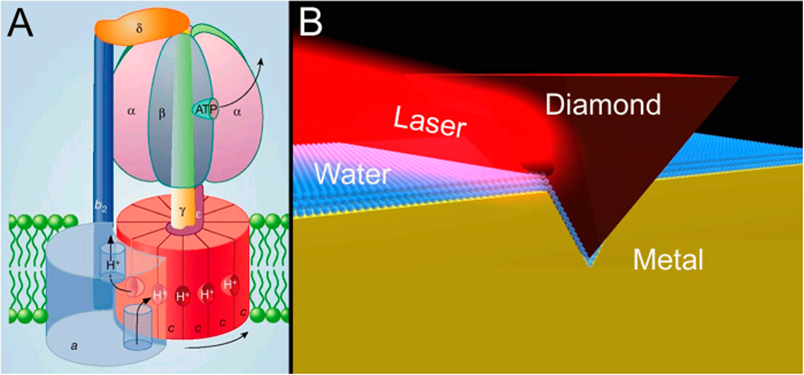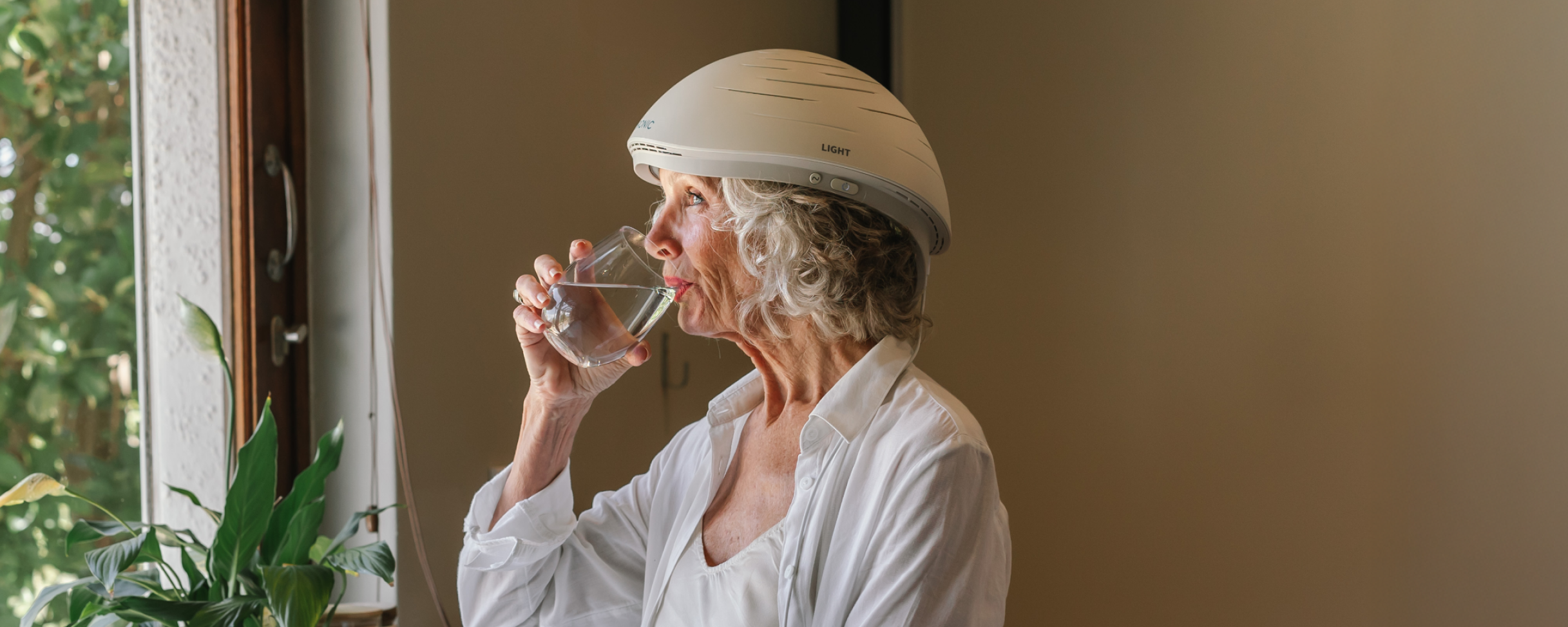What Most People Miss About PBM? Hydration.
We always recommend having a glass of water before your light therapy session, but why?
Water Plays a Key Role in Light Absorption and Signaling
By molecular count, water vastly outnumbers all other molecules in the human body, making up over 90% of the total molecules in a typical human cell (Cooper, 2000). Water is more than just a medium for biological reactions, it actively participates in light-based signaling.
Photoreceptors are molecules that absorb and use photonic energy to drive biological processes. Cytochrome c oxidase is the most established photoreceptor for red and near-infrared (NIR) light. Water also absorbs NIR light, particularly at longer wavelengths, acting more as a physical absorber that influences tissue dynamics, rather than a biochemical photoreceptor.
A concept known as the water oscillator hypothesis describes how water provides a complementary pathway for absorption and transportation of NIR energy through photomechanical means (Santana-Blank et al., 2010). As PBM interacts not only with cellular structures but also with the aqueous microenvironment, hence, ensuring proper hydration is essential for maximizing therapeutic outcomes within the field of PBM.
NIR light structures water around hydrophilic surfaces like cell membranes, this alters the viscosity and structure of water, further supporting its role as a biological modulator. Properly hydrated tissues contain higher levels of structured water which contributes to improving the efficiency of cellular processes like protein folding, cell signaling and ATP production (Sommer et al., 2015).

Mitochondrial Efficiency & Tissue Transparency
Dehydration causes cell shrinkage and compromises intracellular processes, reducing mitochondrial efficiency and blunting the metabolic response to PBM. Ensuring cells are well-hydrated enhances their ability to respond to photonic stimulation, thereby optimizing energy metabolism.
Hydration directly impacts how light travels through biological tissues, as effective light penetration and absorption relies on tissue transparency. Hydrated tissues are less dense and scatter less light, increasing photon penetration and absorption.
For example, a study published in Clinical, Cosmetic and Investigational Dermatology found that increasing dietary water intake improved skin hydration and biomechanical properties, potentially enhancing light transmission through the skin and underlying tissues (Palma et al. 2015).
In another study, gingival wound healing post-surgery was improved when PBM was combined with hyaluronic acid gel which has been shown to be highly hydrating (Yakout et al., 2023). Although this research focused on surgical outcomes, it highlights the synergistic effect of hydration and PBM on tissue repair.
Hydration in Brain-Based PBM
The human brain is composed of approximately 80% water (MacAulay, 2021). In transcranial photobiomodulation (tPBM), hydration plays a key role in supporting the glymphatic system, which clears toxins and distributes nutrients through cerebrospinal fluid (CSF). Enhanced CSF flow from proper hydration may improve PBM’s cognitive benefits by supporting neurovascular coupling, the mechanism by which active brain regions receive increased blood flow and energy substrates.
Hydrogen-Rich Water & PBM
A pilot clinical study investigated the combined effects of electrolyzed hydrogen-rich water and PBM therapy in individuals with Parkinson’s Disease. The goal was to enhance mitochondrial function and antioxidant defenses. Although the study focused on neurodegenerative disease, it suggests that hydration, especially with bioavailable structured water, can potentiate PBM outcomes (Hong et al., 2021).
Thermal Regulation & Circulatory Support
PBM can induce localized increases in tissue temperature, and proper hydration supports thermoregulation, reducing the risk of overheating. It also enhances vascular function, helping deliver oxygen and nutrients while clearing metabolic waste, both crucial following PBM treatments.
To Summarize, Hydration..
- Enhances Light Penetration: Hydrated tissues scatter less light, allowing deeper and more effective delivery of photons to mitochondria.
- Boosts Mitochondrial Function: Hydrated cells have better metabolic responsiveness, improving ATP production during PBM.
- Supports Healing & Cellular Signaling: Hydration facilitates nutrient and oxygen transport, nitric oxide-driven blood flow, and efficient waste clearance - all essential for tissue repair and cellular function.
Hydration Guidelines for PBM treatments
- Drink 250–500 ml of water approximately 30–60 minutes before a PBM session.
- Avoid diuretics such as caffeine and alcohol prior to therapy, as they can dehydrate tissues and reduce PBM efficacy.
- Taking a shower or bath beforehand helps ensure the skin is well-hydrated.
References
Cooper, G. M. (2000). The Molecular Composition of Cells. https://www.ncbi.nlm.nih.gov/books/NBK9879/
Hong, C. T., Hu, C. J., Lin, H. Y., & Wu, D. (2021). Effects of concomitant use of hydrogen water and photobiomodulation on Parkinson disease: A pilot study. Medicine, 100(4), e24191. https://doi.org/10.1097/MD.0000000000024191
MacAulay, N. (2021). Molecular mechanisms of brain water transport. Nature Reviews Neuroscience, 22(6), 326–344. https://doi.org/10.1038/S41583-021-00454-8,
Palma, L., Marques, L. T., Bujan, J., & Rodrigues, L. M. (2015). Dietary water affects human skin hydration and biomechanics. Clinical, Cosmetic and Investigational Dermatology, 8, 413. https://doi.org/10.2147/CCID.S86822
Santana-Blank, L., Rodríguez-Santana, E., & Santana-Rodríguez, K. (2010). Theoretic, experimental, clinical bases of the water oscillator hypothesis in near-infrared photobiomodulation. Photomedicine and Laser Surgery, 28(SUPPL. 1). https://doi.org/10.1089/PHO.2009.2647,
Sommer, A. P., Haddad, M. K., & Fecht, H. J. (2015a). Light Effect on Water Viscosity: Implication for ATP Biosynthesis. Scientific Reports, 5, 12029. https://doi.org/10.1038/SREP12029
Sommer, A. P., Haddad, M. K., & Fecht, H. J. (2015b). Light Effect on Water Viscosity: Implication for ATP Biosynthesis. Scientific Reports, 5, 12029. https://doi.org/10.1038/SREP12029
Yakout, B. K., Kamel, F. R., Khadr, M. A. E. A. A., Heikal, L. A. H., & El-Kimary, G. I. (2023). Efficacy of hyaluronic acid gel and photobiomodulation therapy on wound healing after surgical gingivectomy: a randomized controlled clinical trial. BMC Oral Health, 23(1), 1–11. https://doi.org/10.1186/S12903-023-03519-5/FIGURES/6










.png)



